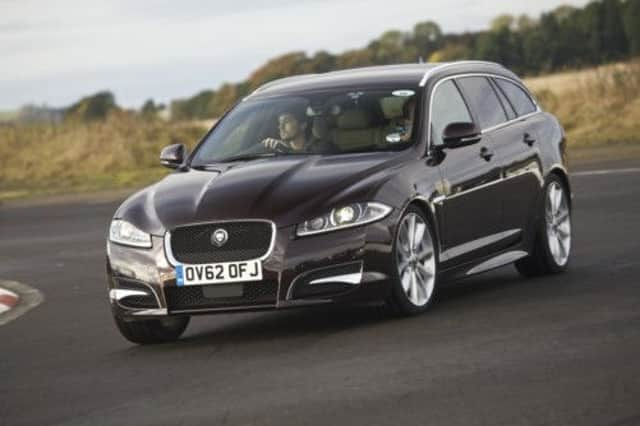Sleek Jaguar Sportbrake sets the standard


Other than coach-built estates in low numbers, Jaguar has only given us two production estate cars. The first, from 2004 to 2009, was the X-Type, offered with both front and all-wheel drive. It was a sleek estate and has not lost its looks in the years since its demise.
The end of production at Halewood overlapped the arrival of the luscious XF saloon from Castle Bromwich. The XF estate started appearing last year – most notably at the official support vehicle for Team Sky in the Tour de France cycle race. Retail deliveries came later in the year and it is still a rare sight. Well, so rare that I have not seen any – other than the car Jaguar loaned for evaluation.
Advertisement
Hide AdAdvertisement
Hide AdIt sits well on the saloon chassis, with an almost elegant side profile. There is a broad tailgate – with an aperture which is as wide as the cargo area (measured at 43 inches wide and 43 inches to the rear seats). That makes a square load deck, with more space underneath for a spare wheel and oddments. This floor has inset channels for the sliding cross frame – useful for segregating luggage.
The rear seats have an easy flip release, extending the flat deck. There is a netted side pocket and opposing compartment. The top-hinged tailgate is powered and can be operated remotely using the key pad. It does not have automatic cut-out so watch where you open and close it.
It is virtually the same length as the saloon and has put on very little weight in the conversion to estate – well about 70 kg or 11 stone. In theory, the cornering roll at the back has to increase at high speed because of the greater rear mass and higher centre of gravity but in my hands it never felt unbalanced. This is a car for elegant touring anyway, not mixing it in the bends with the fast set.
Drive is to the rear only. In Britain, Jaguar offers the XF estate only with diesel engines and an 8-speed automatic gearbox. The options are a 2.2 with Ford/PSA origins giving 163ps or 200ps, and a three-litre turbo V6 in 240ps and 275 ps tune. The cheapest is the 163ps SE at £31,940. The premium over the saloon is from £2,000.
On test was the 240ps, 236.6bhp Portfolio at £47,605. Its official figures are 368.5 lb ft of torque, 46mpg, 163g/km CO2 and 0-62mph in 7.1 seconds. The 0-60 time of 6.7 seconds is more flattering. Stop start ignition is fitted. Obviously, no complaints about its sprinting ability – though most of the time I drove it gently with family members aged from five weeks to 92 years. The trip meter quoted 38.6 miles a gallon – not far shy of its official mpg.
It was fitted with Pirelli’s cold-weather Sottozero sports tyres in 245/40 size. They were very good on snow but the low profile may/may not have been responsible for some road shocks at the rear.
The front part of the car is standard XF, so thick screen pillars, a rather resistant dipping action on the lighting stalk, and a regular touch screen system, also used by Land Rover. These items feel a bit dated. The push-button starter, pop-up gear selector and the metal faced vents which open when the car is started are classier details.
Verdict Looks smart, drives that way, too.